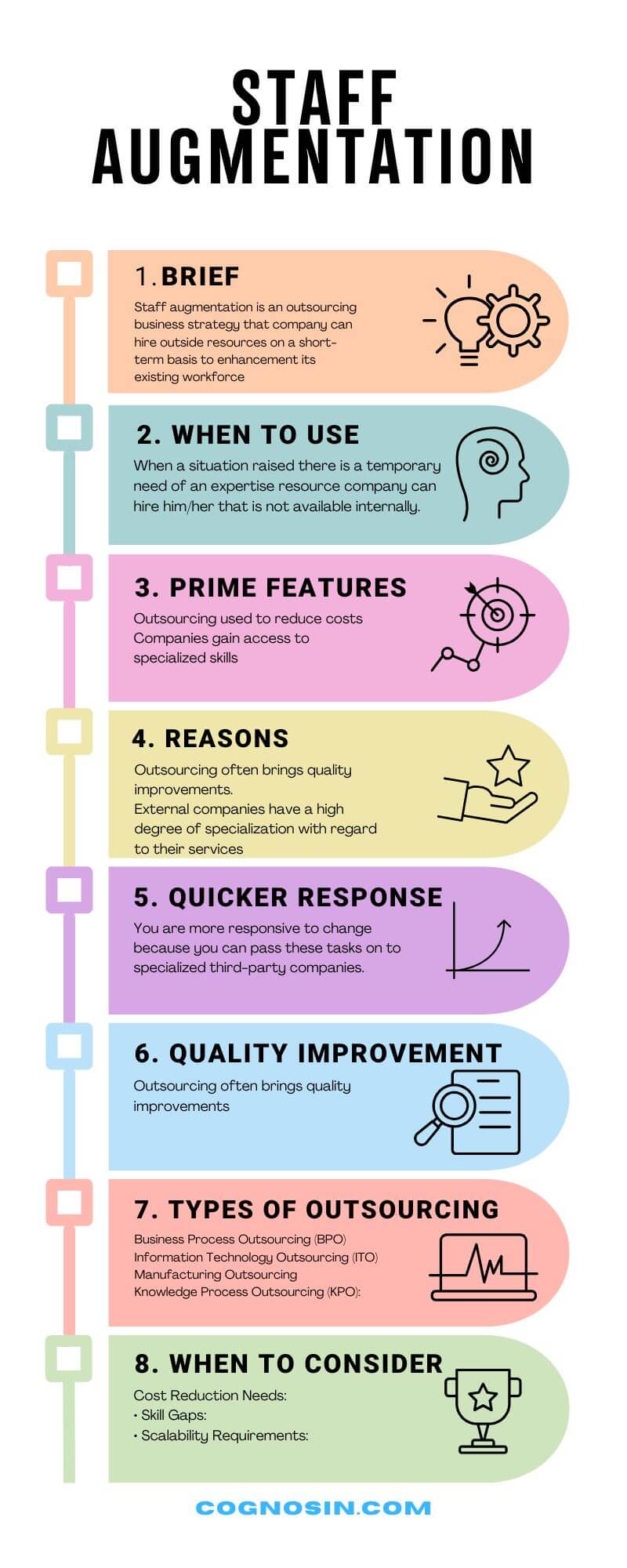Staff augmentation is an outsourcing business strategy that company can hire outside resources on a short-term basis to enhancement its existing workforce. The technique consists of evaluating the existing staff and then determining which additional skills are required. Organization can quickly fill skill gaps. Based on project demand they can scale their team up and down and maintain flexibility without committing to long-term employment contracts.
Characteristics:
• The augmented staff works under the direct supervision of the hiring company.
• Provides flexibility in scaling the workforce up or down based on project needs.
• Is suitable for short-term projects.
Whenever company needs specific skilled employee
When to Use Staff Augmentation
• Project-Based Work: Ideal for projects with defined start and end dates that require specific skills.
• Seasonal Demands: Staff Augmentation is Suitable for industries with fluctuating workloads. Whenever the resource demands team will scale up. Eg: retail or tourism.
• Skill Shortages: When a situation raised there is a temporary need of an expertise resource company can hire him/her that is not available internally.
Advantages:
• Company has the control of project management and processes.
• Easily and rapidly hire resources without giving long-term commitment.
• Integration between hired staff and the in-house team is easy.
Disadvantages:
• To manage and integrate augmented staff there need dedicated resources.
• When compared to outsourcing, staff Augmentation has higher costs per resource.
• Temporary staff earn more than permanent employees.
• Hired staff sometime requires more time to adapt to the company’s culture and processes.

In outsourcing companies hire third party organizations to perform certain business services. Otherwise this process will be handled internally. In this process sometimes transferring employees and assets from one firm to another. Companies used outsourcing as a cost-cutting measure or a strategic management tool.
Prime features of Outsourcing
Contractual arrangement or contract agreement is a legal document that guarantees all the most important elements of an outsourcing project. This agreement is detailed description of what work will be handled by the third party. What expectations and requirements you should have to be achieved in deadlines
Cost Efficiency : outsourcing used to reduce costs. that means operational expenses are lower. During the evaluation of an outsourcing engagement through a cost-benefit analysis, you will likely observe minimal or non-existent training expenses.
Access to Expertise: Companies gain access to specialized skills, technology, or resources that may not be available internally.
What are the reasons for outsourcing?
In addition to the hoped-for cost savings of outsourcing, there are other reasons for handing over certain tasks:
Increased efficiency: Companies can concentrate on their core competencies and work more efficiently.
Optimal scalability: Outsourcing increases the availability of labor. As a result, maximum output can be achieved and production guaranteed – even in the event of seasonal or non-operational capacity fluctuations.
Quicker response: You are more responsive to change because you can pass these tasks on to specialized third-party companies.
Quality improvement: Outsourcing often brings quality improvements. For instance, in manufacturing a good factory or workshop can improve the quality of products.
Save costs: External companies have a high degree of specialization with regard to their services. They can work much more cost-efficiently and therefore offer discounted rates.
Lack of know-how: New processes and operations in companies are often necessary, but the employees often lack the know-how and implementation skills required. Outsourcing is an alternative to hiring skilled workers for this

Common Types of Outsourcing
• Business Process Outsourcing (BPO): Outsourcing routine business processes like payroll, customer service, or data entry.
• Information Technology Outsourcing (ITO): Contracting out IT-related services such as software development, infrastructure management, or technical support.
• Manufacturing Outsourcing: Hiring external firms to produce goods or components rather than manufacturing them in-house.
• Knowledge Process Outsourcing (KPO): Outsourcing high-value tasks that require specialized expertise, such as research, analytics, or legal services.
When to Consider Outsourcing
• Cost Reduction Needs: When reducing operational costs is a priority, especially for non-core functions.
• Skill Gaps: When specialized expertise or technology is needed but not available in-house.
• Scalability Requirements: To handle fluctuations in demand without expanding the permanent workforce.
• Focus on Core Activities:
• When it’s important to free up internal resources to focus on strategic goals.

